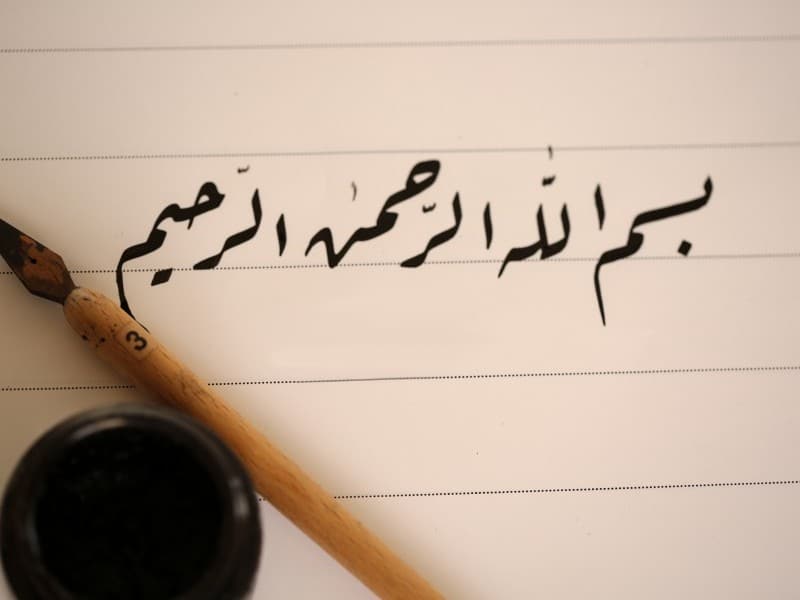In the 7th and 8th centuries, the Arab followers of the Prophet Mohammad conquered territories stretching from the shores of the Atlantic to Sindh (now in Pakistan). In addition to spreading the religion of Islam, the conquerors introduced the written and spoken Arabic language to the areas under their control. The Arabic language was a significant factor in uniting peoples who differed significantly in ethnicity, language, and culture.
Arabic writing at the advent of Islam
In the early centuries of Islam, Arabic was not only the official language of administration but also the language of religion and learning. The Arabic alphabet was adapted to the vernacular languages of the Islamic peoples, just as the Latin alphabet was in the Christian-influenced West.
Arabic is written from right to left and consists of 17 characters which, with the addition of dots placed above or below some of them, provide the 28 letters of the Arabic alphabet. Short vowels are not included in the alphabet, indicated by signs above or below the consonant or long vowel they follow. Some characters can join their neighbors, some only to the previous one, and others to the next. When coupled with another, the character’s form undergoes specific changes.
These features and the fact that no capital letters give Arabic writing its unique character. A line in Arabic suggests an urgent progression of characters from right to left. The beautiful balance between the vertical shafts above and the open curves below the central register induces a feeling of harmony. The particularity that cannot join some letters to their neighbors allows articulation. For writing, the Arabic calligrapher uses a reed pen (قلم) with the working point cut on an angle. This produces a thick downstroke and a thin upstroke with infinite gradation between the two. The line drawn by an experienced calligrapher is a true marvel of fluidity and sensitive inflection, communicating the same action of the master’s hand.
The Kufi script
Generally speaking, there were two distinct scripts in the early centuries of Islam: the cursive script and the Kufic script. For everyday purposes, used a cursive script: typical examples can be seen in the Arabic papyri of Egypt. Rapidly executed, the hand has not been subject to formal and rigorous rules, and not all surviving examples are the work of professional scribes. However, Kufic’s writing has been developed for religious and official purposes. The name means “the writing of Kufa,” an Islamic city founded in Mesopotamia, but the connection between the city and the writing is unclear. Kufic calligraphy is an art based on square and angular writing. Professional copyists used a particular shape to reproduce the oldest copies of the Quran. These are written on parchment and date from the 8th to the 10th century. They are primarily in oblong format rather than codex (i.e., handwritten book). The writing is often voluminous, especially in the early examples, so there may be as few as three lines on a single page! I can hardly describe the script as rigid and angular; instead, the implied rhythm is stately and measured.
The Maghrebi script
Distinctive calligraphies were developed in particular regions. In Andalusia, Maghribi calligraphy (الخط المغربي) evolved into the standard script for the Quran in North Africa. Ultimately derived from Kufic, it is characterized by the exaggerated extension of horizontal elements and final open curves below the middle register.
Taalik and Diwani calligraphy
Persia and Turkey have made contributions to calligraphy. In these countries, the Arabic script was adopted for the vocabulary. Persian scribes invented the Taalik script (خط التعليق) in the 13th century. The term Taalik means “suspension” and aptly describes the tendency of each word to fall from the previous one. At the end of the same century, a famous calligrapher, Mir Ali Tabrizi (Persian: میرعلی تبریزی), evolved nastaalik, which, according to his name, is a combination of Naskh (خط النسخ) and Taalik. Like Taalik calligraphy, it is fluid and commonly used to copy Persian books.
A characteristic script developed in Ottoman Turkey was the one used in chancery and known as Diwani (الخط الديواني). This calligraphy arabic is exquisite and quite challenging to read. Turkish calligraphy is particular to the Tuğra (طغراء), a kind of royal cipher based on the names and titles of the reigning sultan and worked into a very complex and beautiful design. A distinctive Tuğra was created for each sultan and affixed to the imperial decrees by a skilled calligrapher.











